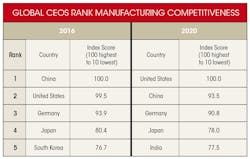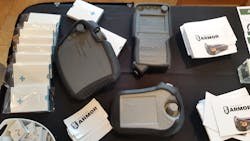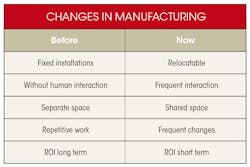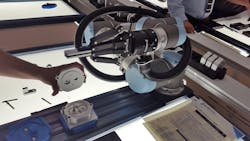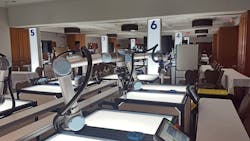In Quebec City, Canada, from September 11 to 13, teams of engineers, salespeople, and managers attended Robotiq User Conference 2017 (RUC 2017). This show was unlike what most others have experienced. It started innocently enough, introducing CEOs from several different companies to talk about the future of manufacturing. But by the end, this show would erupt into an all-night competition of humans and machines.
The Start
Michelle Drew Rodriguez, leader of the Deloitte Center for Manufacturing Insights and a senior manager at Deloitte Services LP, opened the show. In her presentation, she discussed the current countries considered the “powerhouses of manufacturing,” and the countries likely to hold that moniker in the future.
Having the U.S. back on top in manufacturing sounds great, but the top nine out of 15 manufacturing countries will be in Asia. In addition, having a skilled labor force will be essential to staying on top. Six out of 10 open skilled production positions go unfilled due to talent shortage.
By 2025, Deloitte expects 2 million jobs will go unfilled due to a skills gap. In the U.S., 46% of employers are having difficulty in filling jobs across all industries, and it’s expected to get worse. On the other hand, our closest competitor, China, finds that only 10% of its employers are experiencing difficulty in filling positions.
As robots become more popular, the industry may see an increase it pendants and an increase in pendants being dropped. These 3D-printed pendants from Pendant Armor are replicas that assure a perfect fit, and even have weight added to them so that they are the exact weight of the actual pendants.
“In the last 10 years, talent has been the number one driver in manufacturing,” says Rodriguez. While technology like advanced automation and collaborative robots (cobots) are trying to fill the gaps in our talent pool, if we don’t grow and educate our workforce, the U.S. will not be able to sustain its status in manufacturing.
Rodriguez finished with a quote from Leon C. Megginson, professor of management and marketing at Louisiana State University at Baton Rouge: “According to Darwin’s Origin of Species, it is not the most intellectual of the species that survives; it is not the strongest that survives; but the species that survives is the one that is able best to adapt and adjust to the changing environment in which it finds itself.”
Cobots and the Promise of Industry 5.0
There is a time and a place for cobots and traditional robots that require safety caging. Currently, most of the cobot market is in material handling, machine tending, and packaging. However, it is an exponentially growing technology that’s finding new applications all the time.
Following Rodriguez on stage was Esben H. Ostergaard, CTO of Universal Robots. Ostergaard mentioned Industry 5.0 and how it will give power back to the workers. Technology such as cobots will transition from blue collar to a mix of blue/white-collar production. It will not be human versus robots, but rather humans working with robots that will dominate future production. Three points from Ostergaard’s presentation really drove home this point:
1. Two-thirds of employers say that there is already a skills shortage. Meanwhile jobs are moving back to the U.S.
2. Only about 10% of jobs are fully automatable.
3. Employers have shown a 50% increase in production with no job losses.
A large drive for more cost-effective robots and automation that offer a faster ROI may be to appealing to smaller companies. Approximately 97% of manufacturing is made up of small companies (50% by volume), according to Ostergaard. Flexible machines with a fast ROI might be what some small companies need to stay competitive or grow into a bigger manufacturer. One factor that greatly affects an ROI will be how fast a company can get its robots up and running. Installation and training can seriously affect the ROI of automated devices.
This segued into CEO of Robotiq, Samuel Bouchard, introducing his new book “Lean Robotics,” and the company’s new software platform. Takeaways included:
- Insights: A real-time robot-monitoring system that provides the data to maximize cell efficiency.
- Skills: A faster, simpler way to program, with some preprogrammed lines that could be compared to function blocks in ladder logic.
- Blueprints: A cloud-based platform that keeps all communication, changes, programs, and more in one location for streamlined documentation.
This new platform lets companies get new technology up and running faster. How much faster? Well, at the start of day two at RUC 2017, we walked into a room filled with 40 Universal Robots that featured Robotiq’s gripper, all of which was set up in a day. Over the next 24 hours, attendees would program these robots to form a fully functioning assembly line.
Pump Up the Challenge
This challenge isn’t as easy as it sounds—many of the parts need to be indexed properly, and bolts required a specific torque.
The robot challenge involved assembling, inspecting, and disassembling a pump. While some teams worked into the early hours of the morning, showing that there is always room for improvement, all eight teams produced fully assembled parts within the 24-hour challenge. While the teams were tired, they along with Robotiq and Universal Robots turned an empty conference room into an advanced manufacturing facility in two days.
Team 8 was first to produce products, but team 4 swept the competition.
This was one of the most informative shows I’ve attended, and the most interactive. It was ambitious and perhaps even risky to challenge people who might have little or no experience with your technology to have it all up and running in a day. If your tech isn’t as easy as you think, you might have just left a lot of potential customers with a bad taste in their mouths. Not to mention the difficulty of setting up such a challenge.
The companies involved learned a lot from watching firsthand the hang-ups that the teams ran into, so I assume next year the technology will be even easier to use. This will inevitably mean an even more ambitious challenge for next year’s RUC.


